Natural burial is challenging cemetery design and our increasingly toxic death management practices, while also finding potential for new expressions of thoughtfulness and beauty along the way.

By Foreground
In the 19th century, new cemeteries were designed for more than the dignified internment of departed loved ones. The landscape or garden cemetery provided much needed green open space for increasingly crowded cities. Cemeteries were the first public parks, where people came to picnic, relax and court. The pressure of today’s growing and diversifying populations and expanding cities are, again, challenging cemetery design, as well as burial practices. But as well as century-old concerns regarding space and the potential health risks of living close to overcrowded urban burial grounds, a new raft of threats are emerging. Modern burial practices have evolved to become highly toxic contributors to landscape contamination.
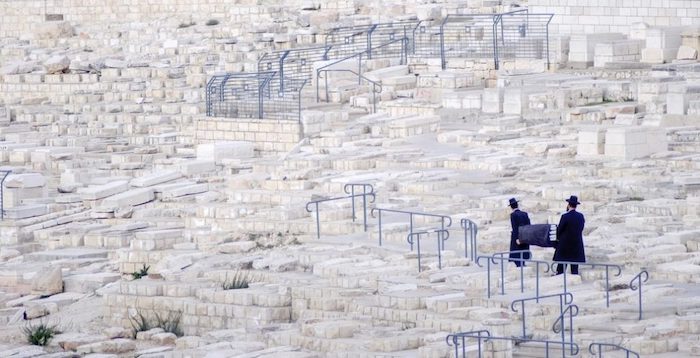
The world is increasingly concerned with environmental degradation, yet funeral practices have been largely overlooked until recently. In the mid-1990s, the National Centre for Groundwater Research and Training at the University of Technology, Sydney, examined nine cemeteries and crematoria around Australia. It found the biggest problem with these facilities was the potential for contamination from infiltrating stormwater carrying toxins from caskets and bodies to the underlying water table. But it took another decade for significant wide-ranging studies to emerge. The UK’s Environment Agency 2004 report into potential groundwater pollutants from cemeteries considers many factors leading to soil and groundwater contamination from human burial, including the organic and inorganic matter of bodies, coffins and other non-body grave contents.

Cemeteries are among the most toxic of modern landscapes in both their immediate and ongoing environmental impacts and intensive use of resources. The 2014 documentary A Will for the Woods outlines the problem of a typical American-style funeral, citing the toxic, resource-intensive materials of caskets that have become common in much of the world. “In the U.S. alone, approximately 33 million board feet of mostly virgin wood, 60,000 tons of steel, 1.6 million tons of reinforced concrete, and five million gallons of toxic embalming fluid are put into the ground every year.” They note further the large tracts of land and high maintenance of constant mowing, watering, and the application of chemicals.
Cremation is mistakenly thought to be more green. It actually releases considerable particulate pollution, CO2 (approximately 50 kilograms per cremation, on average), and toxins such as dioxins, furans, and mercury into the atmosphere.
Then there are a host of more modern elements such as mercury from dental fillings, pacemakers, esophageal tubes and other body implants which leach into groundwater once the body has decayed. Another significant pollutant emerged as people began to be buried with their mobile phones and other electronic devices. The trend was noticed in the United States when batteries started exploding during cremations.
Various environmentally-friendly techniques are being explored to dispose of bodies, including freeze-drying, shattering and dissolving. These offer significant space and land savings with minimal energy use and pollution compared with cremation. They also offer new, as yet unexplored, potentials for interment design and funeral landscaping.

A landscape history of burial grounds
Until a little over a century ago, cemeteries were located in churchyards or nearby. As churches were typically sited on high ground, there were few problems with leaching into groundwater or waterways. Still, overcrowding and the fact that urban graveyards were not always on elevated ground contributed to the potential for corpses to pollute groundwater, especially during epidemics of disease and plague, such as cholera and yellow fever. It wasn’t until Dr John Snow, one of the founding fathers of modern epidemiology, proved the vital connection between groundwater and the spread of disease that it was acknowledged. Snow’s famous map – an original type of infographic – of 13 public wells and clusters of cholera outbreak in London’s Soho in 1854 led to water testing that isolated the responsible bacterium. In 1924, Walter Bell wrote that he believed the lessons had still not been learnt from London’s Great Plague of 1664, when groundwater below “thickly buried” church grave yards contaminated the parish wells.
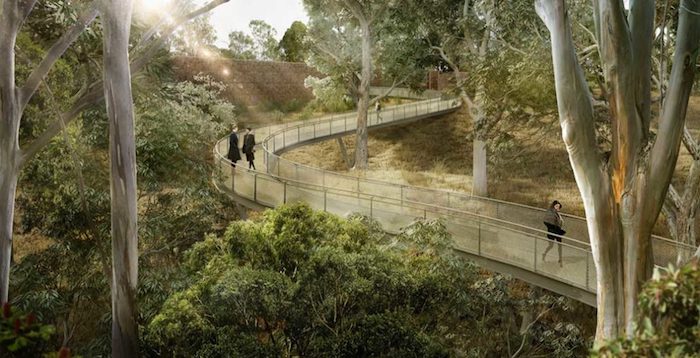
The mass-migration of rural workers to cities during the industrial revolution in Britain meant that new urban cemeteries were needed. However, so too was recreational open space. Long before Birkenhead Park inspired Frederick Law Olmsted’s Central Park in New York, landscaped cemetery-parks of Europe such as Pere Lachaise Cemetery, which opened in 1804 in Paris, quickly led to similar cemeteries in the United States. The same motivations to provide public parks for healthful recreation encouraged ‘rural’ cemeteries to provide a soothing, meditative natural environment and escape from urban crowding. Mount Auburn Cemetery near Boston, consecrated in 1831, was the first rural, or garden, cemetery in the United States and stills serves its dual role as sacred site and pleasure ground.
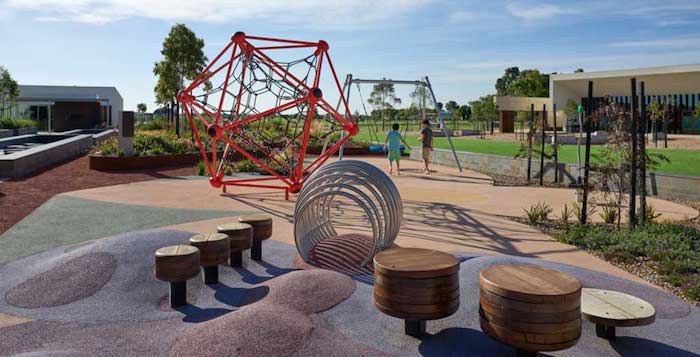
Olmsted worked closely at the Sanitary Commission with Montgomery Meigs, quartermaster general of the Union Army during the Civil War. Meigs sought Olmsted’s advice in landscaping cemeteries. Olmsted prophetically warned that the current fashion for elaborate and artificial gardening should be avoided because it would disappear and advised planting a sacred grove for the war dead using indigenous trees.
The pursuit of urban environments inclusive of the civilising influence of nature was a project that attempted to mitigate the pollution – literal and figurative – of the industrial city. A new and civilised urban landscape was proposed, whose open environment would contribute to “making the city more and more attractive as a place of residence”. There is something of this 19th-century ambition in 21st-century efforts to cleanse cities of contaminating influences. Both publicly- and privately-sponsored greening of city spaces can lead to the eviction of those some might consider undesirable.
More than half of all the cemeteries in the UK were constructed between 1851 and 1914, encompassing the initial emergence of multifunctional landscaped garden cemeteries, followed by the move to more efficient lawn cemeteries. It is likely a much larger proportion were established in Australia during that same time and following the same fashions. Melbourne General Cemetery, opened in 1853, was Victoria’s first ‘modern’ cemetery, designed like a large public park covering 43 planted hectares with generous walking paths and scenic views.
Woodland Crematorium and Cemetery in Stockholm, designed by Erik Gunnar Asplund with Sigurd Lewerentz, is among the most famous and beautiful burial grounds in the world. Although the design evolved during the course of the project from 1915 to 1940, the tranquil, rolling landscape, devoid of graves, echoes some of the aspirations of natural burial grounds. MoMA has exhibited the architectural and landscape drawings of Asplund since 1978. The curators note of Woodlands that the designers wished to “communicate the importance of nature, to which all living things ultimately return”. In 1994, the Woodland Cemetery became one of the few works of 20th-century architecture to make UNESCO’s World Heritage List.
Despite recent concerns over the toxicity of modern burial practices, old cemeteries and burials still have potential to contribute to soil and groundwater toxicity. In particular, Civil War graves in the United States contain bodies that were embalmed with various unregulated secret formulas, laced with arsenic. Embalming was a growth industry during the Civil War era, being the best way to preserve bodies to be returned to distant loved ones. Arsenic does not degrade as bodies rot and so is deposited in the soil and eventually groundwater. It is a carcinogen associated with skin, lung, bladder and liver cancers, among other diseases and cognitive deficits in children.
Another emerging concern with older graves is rising groundwater levels and higher tides. As sea levels rise with global warming, this could lead to contaminated leaching in the near future. It is already having effects in vulnerable low-lying communities where cemeteries are among land urgently being protected.
Natural burials can mitigate, and perhaps eliminate, pollution
There are several reasons why natural burials – also termed green burials or green funerals, organic burials, woodland burials and bushland burials – are becoming more popular. However, a consistently strong motivation is to reduce environmental impacts, including direct toxic contamination of existing sites, and the protection of particular landscape ecologies. Natural burial can do this in several ways: digging shallowly without heavy earth-moving equipment, preparing the body without chemical preservatives or disinfectants, using a compostable coffin or shroud or none at all, avoiding burial of any other toxic or non-biodegradable items, having no headstone or high embodied-energy marker, and conducting any services including food, printing, transport, music and more and in a sustainable non-polluting, no- or low-energy way.
Landscape architect and academic Andy Clayden of the University of Sheffield, researches the planning, design and management of cemetery landscapes. He has led a team that co-authored the first book to review the history and past 20-year growth of natural burials: Natural Burial: Landscape, Practice and Experience, published in 2014. In a paper last year his team focused on the significant contributions of natural burial sites to ecosystem services in England. The ecological benefits are mirrored by shifting perceptions as “natural burial is transforming the traditional cemetery, with its focus on an intensively managed lawn aesthetic, towards a more habitat rich and spatially complex landscape with its own distinctive identity.” Coupled with an ethical-aesthetic shift in death management, this approach is opening many areas of potential engagement and exploration for designers across the full spectrum of services.

A number of organisations have emerged to variously support and oversee natural burials. The United Kingdom’s Natural Death Centre is the oldest, established in 1991 and offering support, advice and extensive links to information for the public. The Green Burial Council in North America, founded in 2005, offers certification as well as education and advocacy. Also established in 2005 is Canada’s Natural Burial Association, serving both the public and burial operators. In 2014 a diverse group of professionals in Australia founded the Natural Death Advocacy Network (NDAN) with a wide remit to advocate, as well as encourage discussion and conduct and disseminate research.
One important aspect of natural burials is the covering a body receives. A co-founder of NDAN and passionate advocate for natural burial, Dr Pia Interlandi, has researched the effects of clothing and textiles on decomposition. Her PhD involved rigorous immersion in the rituals associated with preparing the body for interment. Garments from this investigation have been exhibited at the London Science Museum and London Print Studio. In 2012, she started her current practice, Garments for the Grave, where she now designs custom-made biodegradable burial garments with client family participation.
Australian natural burial sites
Bushland or natural burial is possible in portions of many cemeteries throughout Australia, although there has been little attention given to their complex landscape design. Two years ago Burnie City Council looked to offer a dedicated natural burial site in Tasmania, acknowledging the rising interest in natural burials while, capitalising on the state’s clean, green image and natural scenery. Kemps Creek Cemetery, which includes the Sydney Natural Burial Park, claims to offer Sydney’s first eco-burial area. A different and popular service is being offered in the south-west of Victoria. Upright Burials opened in 2010 as Australia’s first vertical burial ground. As well as taking up much less space than conventional burial, the Kurweeton Road Cemetery adheres to many further environmentally-friendly processes such as an absence of any grave-markers. The exact location is GPS recorded and provided to family and friends. Queensland funeral directors advise of two ‘green’ burial sites within cemeteries both operated by local councils: one as part of the memorial gardens at Lismore in northern NSW and another, which is the state’s only registered green burial site, within Alberton Cemetery on the Gold Coast.
An award-winning master plan for Acacia Remembrance Sanctuary within Itaoui Woodland Park was the first of its type planned in Australia. Developed by landscape architects McGregor Coxall working with Chrofi, the project encompassed 10 hectares of degraded, yet protected bush ecology west of Sydney. The design philosophy looked to establish a model that would not only protect, but reinstate the flora and fauna of the site. It has considered ongoing maintenance as part of full environmental considerations, including having all energy requirements generated on site, on-site water treatment and reuse, and limited slashing of the indigenous grasslands to create pathways instead of introducing exotic grasses and regular mowing practices.
Aspect Studios were responsible for the design of 11 hectares of native gardens at Bunurong Memorial Park, which opened in 2016. Much like early garden cemeteries, the realised proposal caters for the wider community’s need for open space, accommodating weddings, funerals and fitness groups, as well as picnicking and play. Bunurong also includes a new natural burial area, Murrun Naroon.
Reconsidered design approaches for cemetery landscapes, both expanding and new, are clearly an important area of innovation that will curb land contamination. However, new building opportunities can also reset expectations. Harmer Architecture’s Atrium of Holy Angels Mausoleum in Fawkner Memorial Park north of Melbourne was a rare chance to interpret a very old form. The nature of mausolea help contain any contaminants by isolating bodies and congregating remains, which takes up less space and resources.
Despite the thorough, successful translocation of 19th-century British garden cemeteries, followed by equal enthusiasm for the shift to 20th-century lawn cemeteries, Australian researchers warned in 2011 that: “If the concept of green burials is to have any degree of success in Australia, burial operators, land managers and planning authorities cannot simply transplant the practices employed in North America or Europe into the Australian context.”
Perhaps a similar translation of considered species, ecology and aesthetics is needed, as was slowly adapted when Australian landscape gardeners and designers such as Edna Walling looked to the British ‘wild garden’ of William Robinson. The wilderness of Britain is not the wilderness of New South Wales or Victoria or the many smaller patches of ecologies that Walling became familiar with while documenting roadside vegetation and that changed her approach to landscape design.
If the natural burial movement is to achieve its fullest potential to enhance environments, rather than just refrain from harming them, designers should aim to serve both new sensitivities around death and memorialisation, as well as new sensitivities toward our threatened environments.
Complete Article ↪HERE↩!
How we can truly support those facing death or grieving over loss
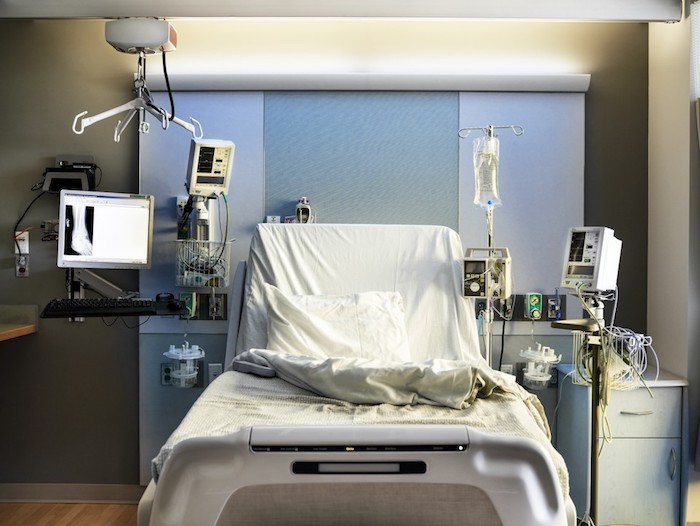
By Dr. Nick Busing
Living well and dying well are what we all hope for. As we face dying and death, we need all the support we can get. It comes from many places, but we all know about the challenges associated with crowded emergency departments, the wait for hospital beds, the inadequate number of community placements, the stress on home care, the shortage of personal support workers … the list goes on.
Most Canadians (75 per cent in recent surveys) want to die at home, but most cannot. Most palliative care today is still provided in the hospital. The reasons are complex and include the lack of adequate home care palliative services and the limited support available to families and caregivers as they struggle to support a loved one at home. Conversations about dying and death are often left too late, when families and friends are in a state of panic, and are unsure what to do, and therefore turn to the local hospital to help them out.
In my more than 40 years as a family doctor, I learned so much from my patients and their families. When I provided end-of-life care in the home, I often noted the critical role of the family and friends in providing support and care to the dying person. Those families who spoke to the dying person well before the last days to understand the values, wishes and beliefs that were important, coped better, as I am sure the patient did as well. This reinforced for me that dying, death, care-giving and loss are social problems with medical aspects and not medical problems with social aspects.

We need to mobilize our communities (person by person, street by street, neighbourhood by neighbourhood) to become better able to support each other as we age. Compassionate Ottawa, a grassroots organization, only two years old, lives by the following vision: A compassionate Ottawa supports and empowers individuals, their families and their communities throughout life for dying and grieving well.Compassionate Ottawa was started by volunteers, and is sustained by volunteers, all of whom want to help our community normalize discussions about dying, death and grieving so that we can reach out to each other to provide support when needed.
The compassionate city movement was started in the United Kingdom and advocates for the role of the community in providing support and care. The long-term goal for us is to achieve a new model of care for those dealing with dying, death and grieving. Compassionate Ottawa is working with schools, workplaces and faith organizations to educate them about planning for dying and death so that they foster resiliency at the individual level. We are conducting advance care planning (ACP) workshops with many community groups. Our compassionate city strives to be one that recognizes that caring for each other should not be left to the health and social services but is the responsibility of all of us.
Amongst its initiatives, Compassionate Ottawa is proud to bring the HELP project (Healthy End of Life Project) to Canada from its origins in Australia. This three-year research project, with funding from the Mach-Gaensslen Foundation of Canada and led by researchers at Carleton University, will work with two faith groups and two community health centres in Ottawa to develop the skills and confidence to offer, ask for and accept help near the end of life. We will identify the challenges and successes we encounter and hope to have lessons that will be of use not only in Ottawa but also in communities across Canada.
We cannot continue to look only to the government’s health and social services to support our friends and relatives as they near the end of their lives. A push for more resiliency in the community would be a great benefit to all of us. And downstream it would mean fewer visits to the emergency rooms, fewer admissions to hospital, less demand for experts, less costly care and, hopefully, a more satisfied and stronger population.
Complete Article ↪HERE↩!
Love at the end of life
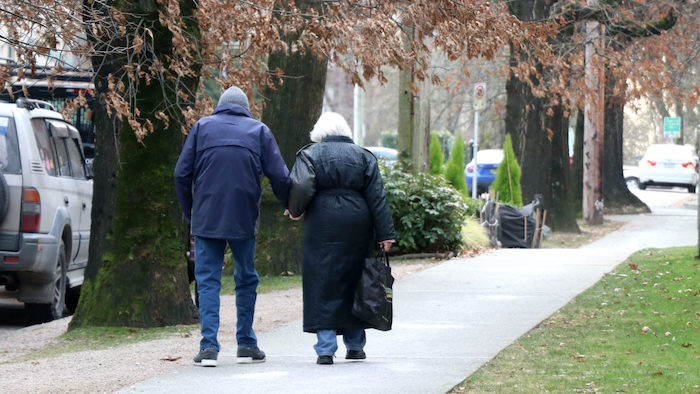
By Maryse Zeidler
Meaghan Jackson has a surprising amount of insight into death and love for a 36-year-old.
“Working here, it’s changed me,” Jackson said from a wood-panelled room at the North Shore Hospice, where she has worked as a music therapist for four years.
“It’s completely changed the trajectory of my life.”
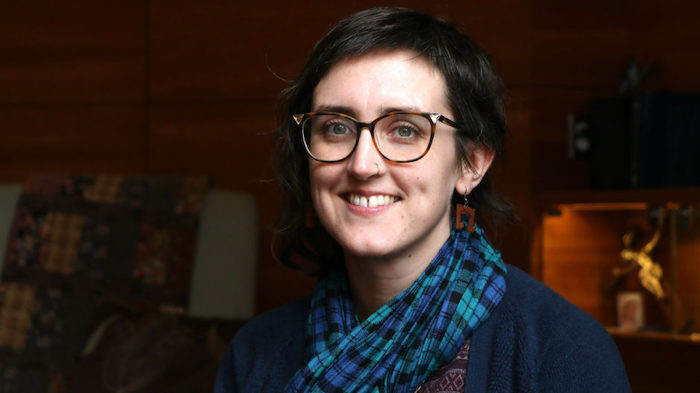
Jackson guides the residents at the hospice through their final days. She helps them write songs for their loved ones, and plays music for them as they take their last breaths.
Jackson has worked in “death and dying” since she was 22. She says her experiences prompted her to have children early in life, and focus on the present, no matter how difficult.
“I practice the art of being present when that present isn’t pleasant,” she said.
Health practitioners like Jackson say their experiences working with dying patients offer insights into love, relationships and how to focus on what matters.
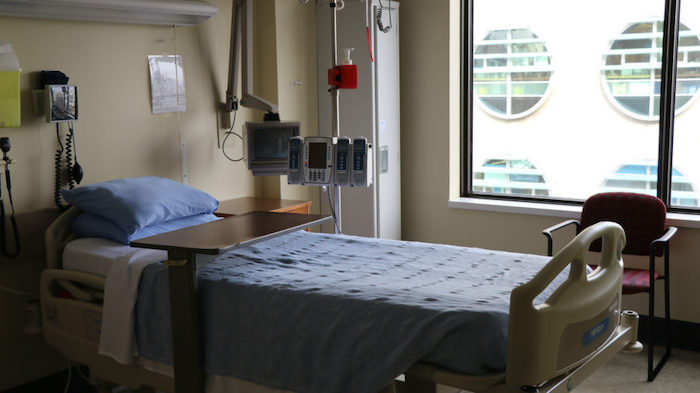
Each of the four practitioners interviewed for this story — a doctor, a social worker, a nurse and a music therapist — say dying patients tend to focus their energy and attention on the people they love.
Dr. Pippa Hawley, a palliative care doctor at the B.C. Cancer Centre, says she has seen couples and families reconcile after decades apart. She’s also seen several of her dying patients get married in the palliative care unit, sometimes in their beds.
Hawley says dying patients don’t have time to take loved ones for granted.
“All of that stuff that we bother with on a day-to-day basis just fades into irrelevancy,” she says.
Dying patients face many challenges with their partners, even when they prioritize love.
Melanie McDonald, a social worker who also works in palliative care at the B.C. Cancer Centre, says every couple she helps deals with death differently.
Couples who thrive during difficult moments are often those who can balance sadness with joy and love, she says.
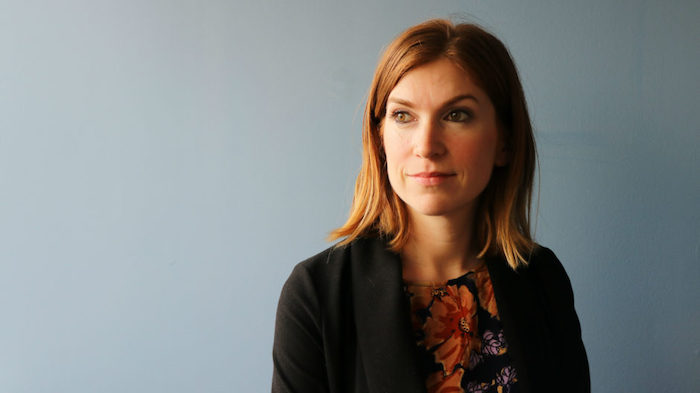
Nurse Jane Webley, who leads Vancouver Coastal Health’s palliative care unit, says the strongest couples are best at honestly communicating their needs, feelings and end-of-life plans.
Webley says patients who find it too difficult to discuss those matters are often the same ones who push loved ones away and face death alone.
“I think that’s a protection mechanism,” she said. “I would say 90 per cent of the time, it’s fear — and that fear is brought about by lack of communication.”
Dr. Hawley says some of her patients are never able to communicate their feelings and needs. Often, she says, that’s been a long-standing issue for them.
“People tend to die as they have lived,” she said.
Talking about death and end-of-life plans is often easier for older couples who are often more in touch with mortality. But Webley says it’s never too soon to have those difficult conversations.
Another challenge couples face when one is dying is learning to give or receive help, health practitioners say.
Social worker McDonald says people who aren’t used to being caregivers, typically men, often struggle when they’re suddenly thrust into that position. But most people learn to take on that role, she says.

Dr. Hawley says patients can face problems as they lose their independence. But she says it’s important for people to let their partners care for them.
“Don’t feel like you’re a burden,” she said. “It’s actually a wonderful gift to be allowed to care for somebody, to show them that you love them.”
All four of the health care practitioners say love at the end of life can take many shapes.
“Love looks differently in different situations,” says social worker McDonald. “Love shows up in the end of life in friendship and in families and pets and faith traditions and all sorts of different ways.”
Complete Article ↪HERE↩!
How To Grieve When A Loved One Chooses To Die
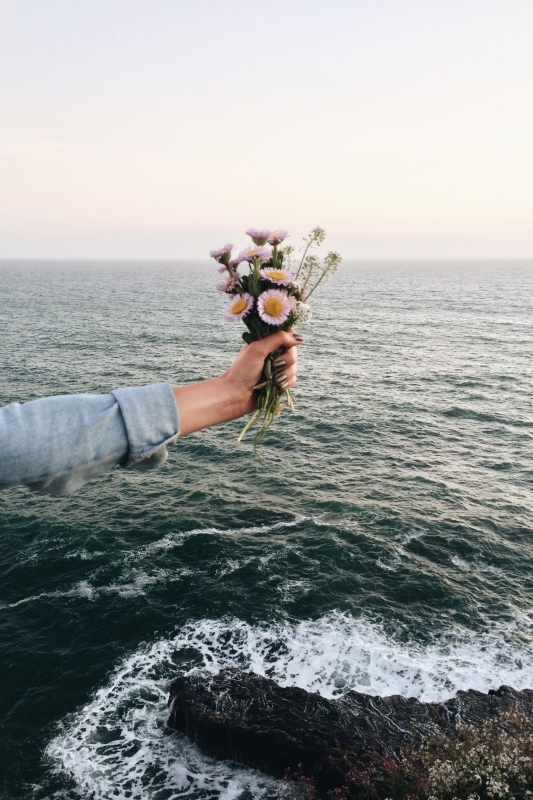
By Chloe Gray
My great grandma, or Mia, as we knew her, was 100 when she decided she was ready to die. I found this out through a nonchalant conversation with my granny, her daughter, just after Christmas. She was eating a bowl of porridge at the breakfast bar, and said: “Mia wants to go, and that’s legal in Canada.”
Was I shocked? Not really. Although I didn’t actually know that Canada, where she had lived all her life, offered medically assisted dying (MAiD), my family are the type to take things into our own hands.
It’s a weird thing, euthanasia. It’s something you’re taught about in RE lessons at school, debating whether we have a right to ‘play God’. It’s something I agreed with as a faraway idea that I’d never have to consider. Something I thought was good in theory but hadn’t ever put any serious thought into the practice.
When I learned about Mia, I agreed with it still. Everyone I told did too, commenting on how brave her decision was and how amazing it was that she had this ‘opportunity’. They may have been thinking about the procedure itself rather than offering support but that was okay, because this was, overall, A Good Thing.
Meanwhile, with my family, talk swiftly turned to logistics. Timetables detailing who would be where and when were emailed around and the bank split Mia’s estate equally, with cheques ready to be collected by her children on the ride home from the facility. It helped the Canadian side of the family to deal with it Monica Geller-style, working pragmatically through the practical elements of her life.
“We’re more open to things that are predictable,” says Dr Anna Janssen, a psychologist specialising in palliative care. “There’s something safer about it, and that means we can be more flexible in our thinking and more open with ourselves and each other.”
But while they were handling the logistical side, it became very clear that we needed to introduce this flexibility into the emotional side of things, too.
The ‘five stages of grief’ ends with ‘acceptance’. The problem here was that for Mia to go with our blessing, we needed to accept her death before she actually died. That’s an unchartered process; grieving while someone is still alive and well(ish) feels weird. My auntie Penny summarised it perfectly, saying she felt she was going through grief sideways, like a breech birth.
Feeling emotion with a deadline meant we had to sprint through the confusion, the sadness, the relief of it all. If we had been Monica about the logistics, we Chandler-ed around the feelings part somewhat chaotically. But we still all felt weirdly…lucky? “With assisted dying, everyone involved has choice in the death,” explains Judy Tatelbaum, author of The Courage to Grieve. “That makes a great difference. Anticipatory grief is very healthy.”
But I was worried about what the minutes and days after she died would bring, seeing as we had already ‘grieved’. “Maybe the grief afterwards is easier, as some feelings have happened already,” said Dr Janssen. “But eventually there will be something new, because the context has changed, and you can’t feel it until the person has actually died.”
And so the 9th of January came. I asked not to know the exact time she was meeting her doctor, because what do you do in the minutes that someone you love is dying? In the most extreme version of the Schrödinger’s cat experiment, I went into a meeting, curious about whether she’d still be alive when I came out. She wasn’t. But there was an email telling the whole story, including how she had greeted the doctor by asking if he was the nice man who was going to help her.
Yes, my experience introduced a new closeness to my family. But it highlighted a flaw in the current MAiD plan. The message from the guidelines, the ethical debates and the psychologists I’ve spoken to is that assisted dying should be about having autonomy. It should make it easier, because you plan and prepare for the place, time, aftermath and even the feelings. But MAiD is such new territory that there are the same unknowns as with ‘regular’ dying.
Up until now, humans have only ever died after suffering through old age or illness or suddenly and shockingly in an accident. Those five stages of grief have been based on these same experiences over thousands of years. Now, suddenly, we’ve introduced a model where death can be scheduled into our diaries, and we can’t just apply the same rules. There are no history or self-help books to teach us how to navigate a brand-new type of grief that brings up a totally different, sporadic, rushed and uncertain feeling.
While there are articles and research papers discussing ethical, religious and legal boundaries, all the conversations have forgotten the people, families and feelings. And maybe that’s because, as Dr Janssen pointed out to me, it’s easier to discuss facts and figures than it is to discuss emotions.
For my family, MAiD was the first time we all properly discussed dying. Perhaps this is the taboo-breaking policy the world needs? You can’t send out a ‘save the date’ without telling people what for, after all. But to stop the turbulence, there’s still a grief taboo that needs to be broken. “We need to talk about the psychology of death and grief, but also the psychology of living. We talked about the death, but not about how we’re then meant to live well,” said Penny.
For families going through MAiD this year, in five years, or further in the future, when it could be a global policy, the system will benefit if we open up. “At the moment we don’t talk about it enough to know whether that [five stages] model requires more thought,” agrees Dr Janssen. “In my academic brain, I’m thinking we need to ask what MAiD means for people, but really, we’ll simply hear more if we take the time.”
My granny has since told me not to be shocked if she asks for MAiD. Is that a conversation she would have had with me if it wasn’t for Mia taking the plunge? Probably not. And while I haven’t yet applied my newfound skill for discussing death with anyone else, I’ll no longer hold back – especially when talking about my own.
Complete Article ↪HERE↩!
What We Talk About When We Talk About Death
One sunny Thursday evening in June, eight people, ranging from thirty-somethings to senior citizens, sat around a table at the Manhattan Jewish Community Center nibbling on cookies.
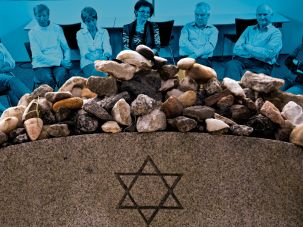 In front of them stood Sally Kaplan, one of three facilitators present from the organization What Matters, a New York City-based not-for-profit that facilitates group and individual conversations about advanced care planning. Sally interrupted the snacking to provide the group with a directive: pair off with the person next to you and talk about when you first realized you were mortal.
In front of them stood Sally Kaplan, one of three facilitators present from the organization What Matters, a New York City-based not-for-profit that facilitates group and individual conversations about advanced care planning. Sally interrupted the snacking to provide the group with a directive: pair off with the person next to you and talk about when you first realized you were mortal.
The participants looked around at each other; a few nervously giggled. There was a moment of uncertain silence. And then, everyone turned to their partner, and a rush of words poured forth. Death, it seems, can be confronted.
The What Matters event is just one example of a surge in Jewish programming focused on end-of-life issues, from speeches to workshops to unstructured discussions reminiscent of Death Cafes, where strangers meet over coffee and cake to talk about any topic related to death they so choose. (I’ve attended and written about death cafes before, although at the earlier ones I attended, participants ate pancakes or Chinese food rather than desserts.) The first “café mortel” was held in Switzerland in 2004. Since then, the movement has spread globally: from living rooms in Cincinnati to (thwarted) plans for a permanent café in London to China, where sickness and mortality remain taboo.
And the death café now has Jewish equivalents: Over the past years, death café-esque events have been held at Jewish community centers, senior homes, synagogues, and even mortuaries. Most recently, a coalition of Westchester County, New York synagogues organized a series[ of “death cafes” (the events were more structured than the traditional café mortel) centered around subjects like Jewish funerals and the afterlife in traditional Jewish thought. In Israel, Rabbis Miriam Berkowitz and Valerie Stessin, who founded the pastoral care initiative Kashouvot, have also hosted death cafes in the past. The Dinner Party, a network of meal-based gatherings for young adults who have experienced loss, currently offers kosher dinners in New York City.
In 2016, Death Over Dinner, an American initiative similar to Death Cafe, partnered up with IKAR, a Los Angeles-based non-denominational Jewish community, and Reboot, a nonprofit Jewish think tank, to launch Death Over Dinner: Jewish Edition.
“We launched [the pilot] on Yom Kippur, because that is the quintessential Jewish moment of facing our mortality,” says Francine Hermelin, the creative director of Reboot. Though Reboot and Ikar have hosted dinners themselves, in addition to having partnered with organizations like Moishe House and the Contemporary Jewish Museum of San Francisco, they also offer an online questionnaire that helps guide a potential host to stage a dinner in his or her own home. They soon plan to add printable cards with verbal prompts, including quotes from psalms, Talmudic wisdom, and food for thought from contemporary rabbis, as an additional resource.
“[This initiative] is to make that personal shift, and ultimately a cultural shift, where talking about death is no longer a conversation we’re afraid of but a conversation that we are embracing,” Hermelin says.
The increased focus on mortality in recent years is likely the result of a combination of factors: an aging population living increasingly longer and facing unprecedented healthcare situations, a greater openness towards talking about historical taboos generally, and a growing consumer interest in wellness, including a concept of “the good death.” And Jewish initiatives focused on death and mourning want to take part in this larger dialogue, using spirituality and Jewish tradition as a foundation. Indeed, a 2017 Pew study found that “geographically and theologically diverse” faith communities were uniquely suited to address concerns around death and mourning, even for those with no prior religious affiliation.
“We [in the Jewish community] seized upon this wave,” says Kaplan, who points to books like Atal Gawande’s On Being Mortal and Paul Kalanithi’s When Breath Becomes Air as examples of the trend. Though What Matters is non-denominational––Kaplan describes it as “value neutral and person-centered”––Kaplan says she sees confronting mortality through discussion as a “very Jewish” enterprise, one she feels is reflected in Jewish texts. “People are surprised that there are so many Talmudic stories that deal with advanced care planning!” For further insight, Kaplan referred me to Rabbi Mychal Springer, Director of the Center for Pastoral Education at the Jewish Theological Seminary, who cites the story of Rabbi Yehudah Ha-Nassi, who was unable to die while his students were incessantly praying for him, until his handmaid dropped a jug from the roof and distracted them. In the moment of silence, Ha-Nassi was able to depart peacefully. ” This is a classic example of the way the rabbis were saying we shouldn’t prolong the dying process,” Rabbi Springer said.
Support doesn’t always come in the form of face-to-face groups: Lab/Shul, a creative Jewish community based in Lower Manhattan, operates an initiative called Kaddish Club, which includes a monthly potluck dinner in New York City, and a 15-minute weekly phone call they’ve dubbed Virtual Mourners’ Kaddish. During the calls, which began in 2014, the far-flung bereaved reflect on their departed loved ones, share some wisdom, and then recite Kaddish together.
“We’ve had folks call in from all over the country and all over the world,” says Sarah Strnad, Lab/Shul’s Director of Operations. “A lot of the traditional options [i.e. daily kaddish in a synagogue setting]… don’t always work in our modern lives.” Strnad says one of the most moving things about the calls is how they end up becoming micro-communities. “Even on the virtual calls, when people might never see each other in person, they remember each other’s stories and they can give each other support week after week.”
Of the current offerings, few are Orthodox in orientation. This might be because those who identify as Orthodox see processes around death as strictly prescribed ––decisions about life support deferred always to the ordained, mourning periods a certain length, prayers predetermined –– and therefore not necessary to hash out.
But Elad Nehorai, founder of Hevria and Forward contributor has imminent plans to hold a death café that will include a more observant audience (though he hopes to provide a space for the observant, he stresses that anyone is welcome). Nehorai, who has attended “secular” death cafes in the past, told me, “It was actually my fascination with death that caused me to choose to be Hasidic after growing up secular. Death has this fascinating power to force us to face what we really believe. Even as believers, we must face our beliefs in a brave way. Death forces us to do that.” (Full disclosure: Elad and I collaborated in organizing this event.)
During the course of my writing this piece, I attended my grandfather’s memorial service, tried to comfort a friend whose loved one was gravely ill, and heard a rabbi speak about ministering to a father grieving for his child as one of his first clerical duties.
Even though I had thought it slight hyperbole when she said it, I realized Francine Hermelin’s assertion that “we’re always experiencing death” was absolutely true. Though we may find it difficult to face our end with courage, as Nehorai hopes we can, we should do our utmost to be as prepared, emotionally, logistically, and spiritually, when the time inevitably comes, for as it says in Genesis, “For you are dust, and dust you shall return.”
Thankfully, there is increasingly more out there to help us do just that.
Complete Article ↪HERE↩!
How to die the way you want
Tackling the tough questions over a cup of tea or coffee
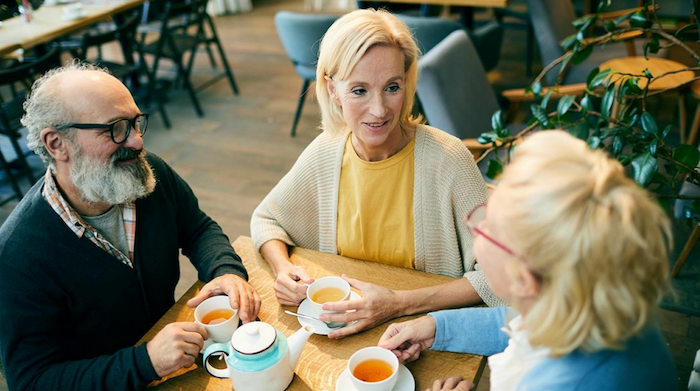
We’re all dying, every one of us.
But we learn early on that despite the fact our lives are universally finite, most people don’t want to talk about it.
We’ll talk sex, we’ll talk drugs, we’ll even talk money—but not death.
That could be changing with the proliferation of so-called Death Cafes, informal get-togethers in cities across America, Europe and Asia, where people eat a little something, drink some coffee maybe and talk about, well, the inevitable.
The mission is to revamp typically depressing and urgent end-of-life discussions to more leisurely “Everything-I-Wanted-To-Know-About-Death-But-Was-Afraid-To-Ask.”
The conversation ranges, and depends on the group of people who’ve gathered: anything from how much a funeral costs to the details of a “green” funeral (think: corpse as compost) to tips on how to talk to your family members about your own funeral.
There’s a range of people who attend, too, from someone who had a death in the family and wants to be better prepared next time, to health care providers who want a different perspective on dealing with death. They range in age from 20-somethings to 90-somethings.
 The object: to turn death from a feared end to something that is part of life.
The object: to turn death from a feared end to something that is part of life.
“Death Cafés change the way you live in the most profound and wonderful way,” says Kim Mooney, 67, who runs monthly meetings in Longmont, Colorado.
Mooney even held a few events in a mortuary. “I like to say it’s the only time you will walk in and walk out of one, so you might as well take advantage of it.”
Death café hosts tend to have a sense of humor.
Death on twitter
If you want to confirm the popularity of the death positive movement, just go on social media. There’s The Death Café Facebook group, which lists times and dates of meeting and has more than 50,000 likes and followers.
Or you could follow Death Café on Twitter.
Advocates say the meetings allow people a low-pressure way to express fears about the Great Unknown; to chat about the way other cultures handle death; and to share practical information, such as learning the nuts and bolts of filling out end-of-life forms.
Talking with strangers, hosts say, is often an easier way to broach the topic before launching a conversation about death with loved ones.
Lizzy Miles is a hospice social worker who hosted America’s first café in 2012 in Westerville, Ohio. She baked cookies in the shape of tombstones with grey icing and “Death Café” where the epitaph normally goes.
She is one of more than a 100 Death Café hosts in this country. She’s still hosting—and still making treats—for nearly a dozen people who show up each month.
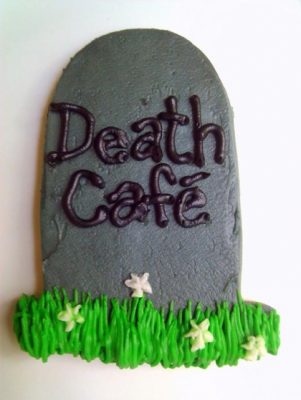
“No one ever comes to a Death Café already uncomfortable talking about death,” she says. “If you are, you’re not going to come. We have a lot of sandwich generation people, who are taking care of their parents.”
Miles is so committed she even traveled to a Death Café in Hong Kong—“on my own dime!”—to see what it was like.
“It was amazing, people were speaking English and Mandarin and Cantonese,” she says. “And I thought ‘Oh my gosh, all these different languages. This is pretty cool but almost exactly the same.’”
Dos and don’ts
Anyone can be a host, but there are guidelines. The Death Café website has a set of guidelines and Miles herself was a co-author on an article that included a list of dos and don’ts in the Omega Journal of Death and Dying:
Do: Allow a space for folks to share their ideas respectfully and openly.
 Do: Offer the opportunity for everyone to speak but allow those who want to remain silent to do so.
Do: Offer the opportunity for everyone to speak but allow those who want to remain silent to do so.
Don’t: Charge an admission fee.
Don’t: Sell death-related products.
Don’t: Turn the group into grief support.
Miles and others believe that confronting our mortality will prompt us to the make the sorts of life changes that some folks do only when confronted with a fatal disease. Why wait?
Shellie Balogh, a 61-year-old hospice nurse attended one of Miles’ cafés in Ohio.
“It wasn’t what I expected; it was more upbeat,” she says. “It’s a fun thing to do if I have a free Saturday. You go and meet people you may never see again and just have this conversation, opening up this forbidden area of discussion.”
A midwife for dying
Suzanne O’Brien hosts a New York City group that meets at a public library on the Upper West side. She’s a nurse turned death doula.
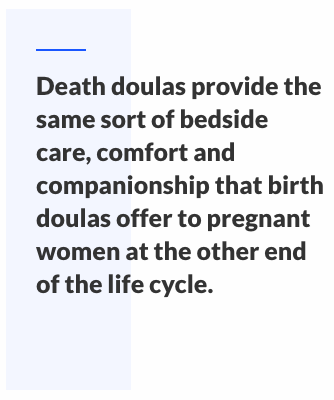 Death doulas—part of this burgeoning “death-positive” movement—provide the same sort of bedside care, comfort and companionship that birth doulas offer to pregnant women but at the other end of the life cycle.
Death doulas—part of this burgeoning “death-positive” movement—provide the same sort of bedside care, comfort and companionship that birth doulas offer to pregnant women but at the other end of the life cycle.
O’Brien said monthly conversations tend to fit into five buckets, sometimes all five covered in one 90-minute session:
The physical: How do I make sure I’m comfortable during my dying hours. What do I want to happen to my body?
The financial: What forms do I need to fill out? Or how much money do I want to spend on a funeral versus, say, end-of-life care?
The emotional: How do we deal with potential regrets or forgiveness?
The mental: Reasoning and acceptance
The spiritual: How do beliefs about death inform the way we live.
One woman wanted to know how to donate her body to a medical school anatomy class. She also wanted to make sure her family would not be given the leftovers when the students are done picking her apart, something she had heard can happen.
She told the group: “I’d rather just be flushed.”
Banishing the secrecy
The idea of a group of a random community members chatting about death over refreshments was the brainchild of Swiss sociologist Bernard Crettaz. He launched a “Café Mortel” in 2004 in the lakeside town of Neuchâtel, Switzerland. A dozen mortal members attended.
The point, as he once told a reporter for the Independent, a British newspaper, was to remove death talk from its “tyrannical secrecy.”
The first cafe outside of Switzerland was held by John Underwood, who hosted in his London basement in 2011. He’s given credit for helping the movement go global; he died last year, at the age of 44, from undiagnosed leukemia.
Today, there are death-with-food meetings in about 55 countries—including the U.K., Italy, Hong Kong, Finland, the Netherlands and New Zealand.
Becoming a regular
Those who are regulars say that while the subject matter is death, the meetings are not sad. Hosts emphasize that they are not grief support groups, more death-curious groups.
Jane Geller, a retired schoolteacher in New York City attends the Upper West Side meeting nearly every month.
“It’s a misnomer to think it’s depressing,” she said. “Death Cafés are really about life.”
 Shatzi Weisberger, an 88-year-old retired nurse from New York City is a regular, too.
Shatzi Weisberger, an 88-year-old retired nurse from New York City is a regular, too.
“I was always especially interested in how we come into this world and how we leave it. When I got into my eighties, I got personally interested for my own edification.”
Last fall, she hosted her own “FUN-eral” (pronounced Funn-eral) in the common room of her apartment building. More than 100 attendees came to the event. It sounded like a macrabe-themed birthday but she said it was a death, not a birth, party. And a way to attend her own funeral.
She said she has planned her own green burial. “I’m going to be wrapped in a shroud and buried in the woods upstate and my body will deteriorate and something will grow. I don’t know if it will be grass or flowers or a tree so I feel my dying is bringing life into the world. That’s not depressing at all.”
Complete Article ↪HERE↩!
What’s Wrong with Dying?
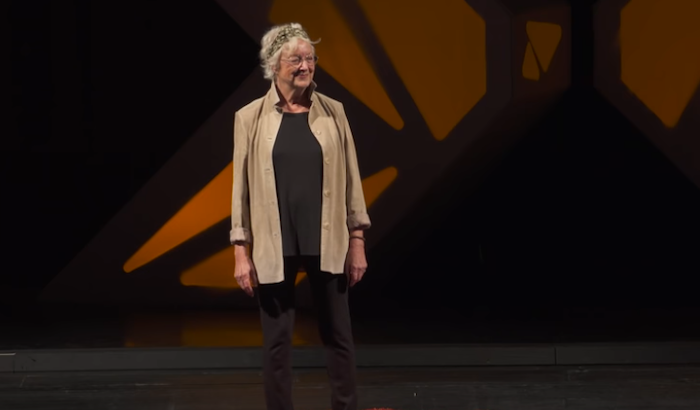
The answer might seem simple, but in the hands of Lesley Hazleton, the question takes us on a surprisingly humorous and thought-provoking journey into what it would actually mean to live forever. And whether we’d truly want to. A frequent TED.com speaker and ‘Accidental Theologist,’ Hazleton uses wit and wisdom to challenge our ideas not only about death, but about what it is to live well.
Lesley Hazleton has traced the roots of conflict in several books, including compelling ‘flesh-and-blood’ biographies of Muhammad and Mary, and casts “an agnostic eye on politics, religion, and existence” on her blog, AccidentalTheologist.com. Her newest book, Agnostic: A Spirited Manifesto, celebrates the agnostic stance as “rising above the flat two-dimensional line of belief/unbelief, creating new possibilities for how we think about being in the world.” In it, she explores what we mean by the search for meaning, invokes the humbling perspective of infinity and reconsiders what we talk about when we talk about soul.
